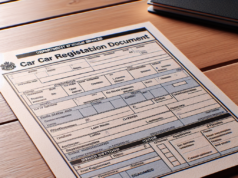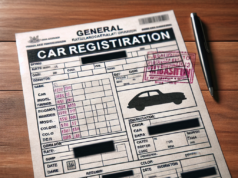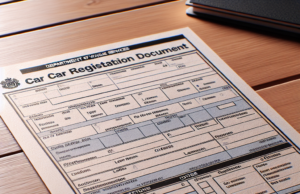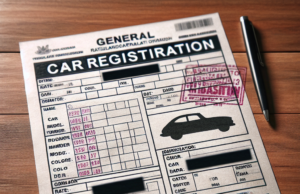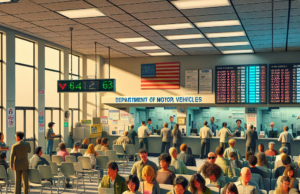
There are many different reasons to temporarily stop while driving. Failure to stop can result in traffic citations, driving points, accidents, or even serious personal injury or damage to property. All states have different traffic laws that require obedience specifically to traffic control devices and signals, meaning that drivers have to observe and obey them when operating vehicles. Here are some signals and devices that require a driver to stop while driving. Failure to stop appropriately can result in different moving violations.
Stop Sign
A stop sign is a type of traffic sign that notifies drivers that have to stop before proceeding. In the United States, a stop sign is 75 centimeters across opposite flats of the red octagon, and it has a 20 millimeter white border. The uppercase white letters that say “STOP” are 25 centimeters tall. Larger stop signs of are 90 centimeters tall with a 30 centimeter word and 25 millimeter border are usually placed on expressways with many lanes. Regulatory provisions for exist for extra-large stop signs with 120 centimeter signs with 40 centimeter legend and a 30 millimeter border that are used when reaction distance or sign visibility are limited, while the smallest stop sign size permissible for normal usage is 60 centimeters with a 20 centimeters legend and 15 millimeter border.
Stop signs are used all over the world. However, many countries see less stop signs than in North America, because all-way stops are rarely used and can often be legally prohibited. Stop signs are usually used in North America to manage conflicting traffic movements at intersections that are not busy enough to have a traffic signal or roundabout installed. The stop sign is not intended to be used as a way to calm traffic, but rather, to provide safety and assign right-of-way in these intersections.
Stop signs are often also placed as a safety measure in residential areas and near areas where children walk or play, like school yards, or areas that are often experience automobile accidents. Stop signs can be placed on all intersecting roads, making three- and four-way stops.
Stop signs are also found attached to pivoting arm on North American school buses. The stop sign stays flat on the left side of the school bus. When deployed by the bus driver while dropping off or picking up passengers, the stop sign pivots out in order to warn drivers against passing the bus illegally. Some buses have two of these stop sign arms, one near the front of the bus and one near the back. The stop sign is retro-reflective and is equipped with red blinking lights, or with the word being illuminated by LEDs.
Stop lights
Stop lights, which are also known as traffic lights, traffic signals, traffic lamps, robots, signal lights, or semaphore, are signaling devices that are positioned at pedestrian crossings, road intersections, and other locations in order to control competing flows of traffic on a road. Stop lights were first set up in London in 1868, and are installed today in nearly all cities globally. Stop lights alternate the right of way by displaying standard color lights (red indicates stopping).
There are multiple types of stop lights or traffic lights that be used. Aside from those that change between red, amber, and green, there are only have a single color or a pair of colored lights that acts as a warning in an intersection with shared right of way. If there is a flashing red light, the stop light should be treated as the same thing as a stop sign or as an indication of a closed road. Flashing amber indicates that a driver does not have to stop, but should be cautious when crossing the road because of some hazard up a head.
Dual aspect stop lights are often found at railway crossing, some street intersections, and areas with emergency department driveways. These stop lights will flash amber if cross traffic is not expected, but will turn red to stop traffic when necessary.
Stopping For Pedestrians
Many jurisdictions require drivers to yield for pedestrians, but not necessarily stop. However there are some that do require it. Pedestrians are usually free to cross the street in accordance to local traffic laws at crosswalks. In most states, drivers must stop and wait only until the pedestrian has crossed at least half of the crosswalk before the driver can continue. However, in other states, such as Utah, drivers require the driver to stop and wait the full time, for example in a school zone when the lights flashing are on, before he or she can proceed.
Some pedestrian crossings also have a stop signal or traffic signal that makes vehicles stop at regular intervals so that pedestrians can cross the street. Others have “intelligent” signals, where pedestrians can press a special button, and the stop signal will schedule a stop so that pedestrians can cross. Pedestrian crossings that do not have traffic signals are also quite common. In this situation, the laws usually dictate that pedestrians have the right of way, and that motor vehicles have to stop in order to allow the pedestrian to cross.
Pedestrians are also instructed to stop and go at specific interviews. In North America, this is typically done through signs that tell pedestrians to walk and don’t walk that are synchronized with the stop lights designated for vehicles.
Stopping for School Buses
Many jurisdictions in the United States (including various overseas territories) and Canada have both adopted different school bus stop laws which require vehicles to stop and wait for a school bus loading that has stopped to load or unload children in order to protect them. Usually, if a stopped school bus is has flashing, alternating red lamps displayed, a driver of a motor vehicle overtaking or meeting the stopped bus from either the front or back direction has to stop and wait until the bus begins to move again or the bus driver turns off the red stop lights. School crossing guards, school bus drivers, and police officers all have the power to wave traffic on, even if the red light is flashing.
On many divided highways, nearly all American jurisdictions do not require drivers to stop if they on the opposite side of the street from the school bus that is stopped. However, some motor vehicles are required to stop, including the following:
• Mississippi
• New York State
• Arkansas, if the divider is less than 20 feet in width
• West Virginia in a non-controlled-access highway
• American Samoa
• Guam
American jurisdictions have tried to deter illegal passing of stopped school buses by increasing the enforcement of these stop laws and setting up heavy penalties, such as fines, points against a driver’s license, and even license suspension in the most severe cases. Nevertheless, violations of these stop laws are very common. A law enforcement officer must actually witness the violation, and even if citations are issued, it is difficult to receive citations due to lack of evidence or reduction of charges.
There are some states that do not have this law in place. Drivers in the state of Washington do not have any requirements by law to stop for a stopped school bus on any road that has three or more lanes if they are traveling in the opposite direction of the stopped bus. This rule has been interpreted to suggest that when approaching a school bus on a normal road with a turn lane from the opposite direction, or a street with two lanes in each direction, a vehicle is not required to stop. While this is an unusual law, it can arguably leads to a more safety for children, since they must be dropped on the same side of the street as the school bus exit on for roads with two lanes. The state of Ohio has a similar exception in the law for vehicles stopping for buses, but rather than it being for roads with two lanes, it applies to roads that have at least four lanes.
Emergency Vehicles
While you do not necessarily have to stop, emergency vehicles such as fire trucks, law enforcement vehicles, tow trucks, paramedic vans always have right of way on a street. If you hear or see an emergency vehicle approaching, you must give them right of way, usually by moving to the far side of the road and either slowing down or stopping there in order to allow the vehicle to go through.

